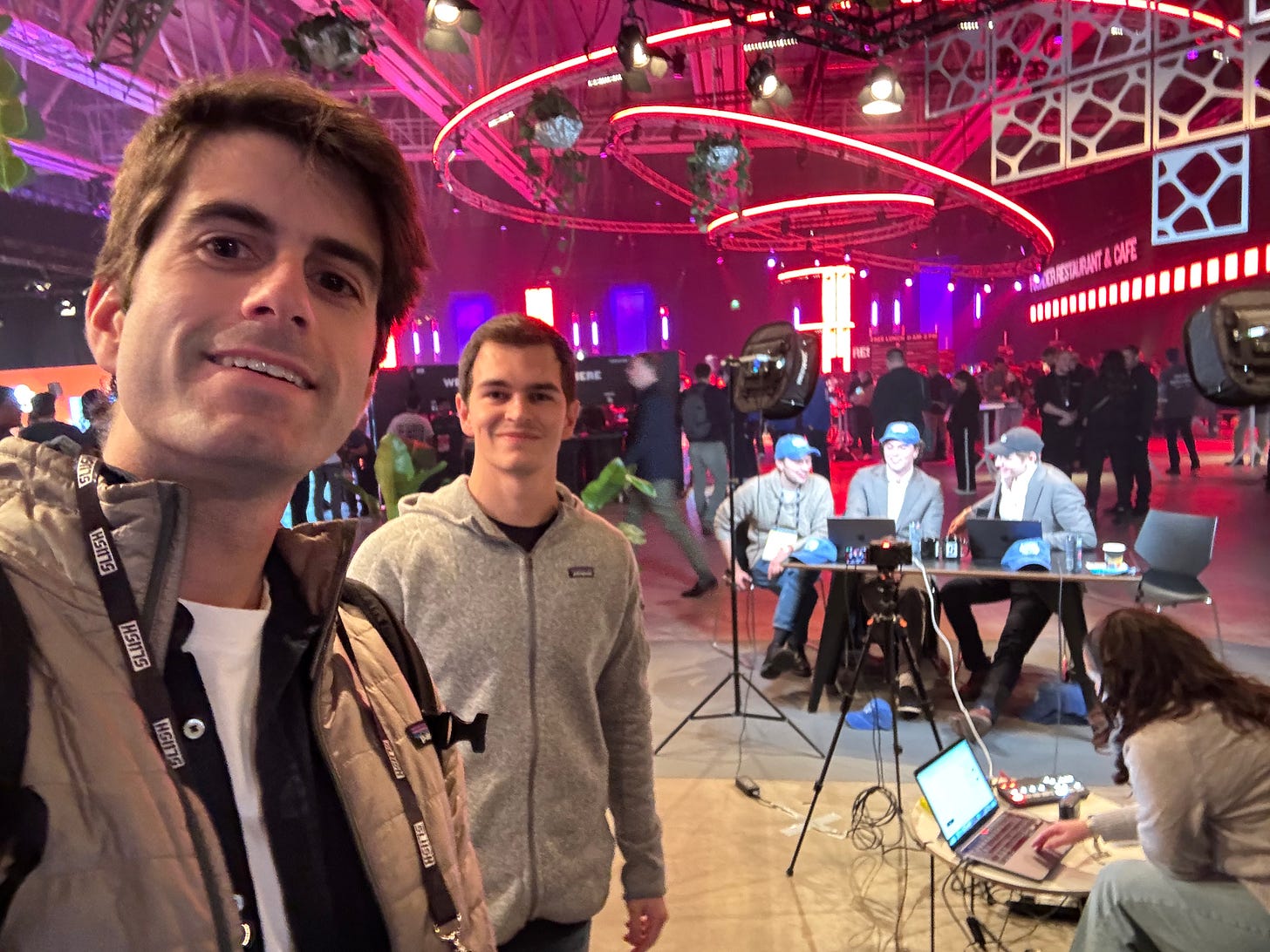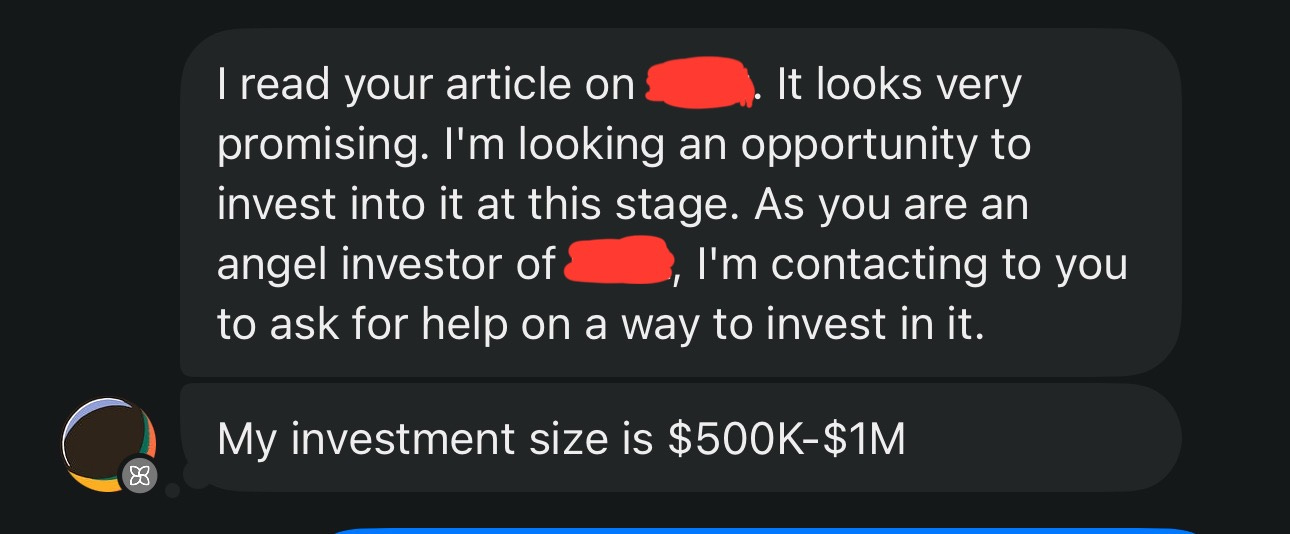How I angel invested in +35 startups in one year, interviewed Mark Cuban and my strategy
Speed, Volume, Iteration: The Framework Behind 30 Angel Investments and Landing Mark Cuban
Hey everyone, welcome to PMF!
This week was super intense with Slush, and you’re not going to believe the people I got to meet and interview (2 unicorn founders and the founder of one of Europe’s top VCs).
I’ll share more about that soon.
On this newsletter I want to break down some of the things I talked about during my live with etn!
For those who don’t know what etn is, here’s their launch video
1. How I angel invested in +30 companies in 2025:
It feels like I’ve lived multiple lifes so far: lawyer, founder, vc and now angel investor.
All of them share several things: I do a lot of reading and writing and those skills + being a huge fan of founders (i founded a startup that failed +5 years ago) allowed me to build a big audience in tech.
What I do today is very simple but requires my 997: I write for founders & vcs and invest in the best founders and then help them with visibility with my writing.
So the path hasn’t been linear, in the past I:
1. Grew a travel instagram account (20K subs): failed
2. Started an investment podcast: failed
3. Worked as a lawyer: not my thing/quit - but learnt so much about business & to read & write really well
4. Tried building a car reselling business: failed
5. Built a startup: failed / but I found my thing
6. Worked in VC: loved it, but wanted to build
7. Wrote about startups: worked, kept doing it working every weekend for 3 years in a row
Fast forward, I’m in path to invest +35 startups in 2025 and double down in 2026!
The strategy behind is: investing + helping founders go viral 🔥
2. How I interviewed Mark Cuban:
Rubén Domínguez Ibar and I interviewed Mark Cuban. This is how we got to him:
3 years ago nobody knew us. So we built distribution first.
That allowed us to start interviewing super interesting people we wanted to meet and learn from.
We shared the interviews and many people liked them, I think mostly because they’re not produced, we’re not pro podcasters and our questions are not scripted.
Then, someone saw it and cold emailed me to interview Mark Cuban, Daniel Lubetzki, Barbara Corcoran and the other sharks 😅
We thought it was phishing but we answered to try some luck and it wasn’t luck! We flew to Las Vegas and did it 🚀
Learnings? There’s a lot of cool people watching what you do, you only need some luck to get to the person that can change your life 🔥
3. Why founders with oversubscribed rounds let us invest
I wrote in my newsletter about a startup I had invested in and it got a $1M investment offer 🤯
Rubén Domínguez Ibar doubled the ARR of one of the companies he had angel invested in with one Linkedin post.
This is the value of distribution and how we’ve angel invested in 30+ pre-seed companies across YC, a16z Speedrun, Pioneer Fund, NFX, Peak XV, Founders Inc and more in one year.
Here’s why founders give us allocation even when the round is full:
Founders want differentiation, storytelling, visibility on Day 1, and momentum around their launch.
If you can help a company reach customers, talent, and other investors, you stop being “another check”. You become an accelerant.
Money is a commodity, you can’t differentiate one dollar from another.
Distribution is the moat.
4. Why I never think strategically
I never think strategically. The only way things ever worked out for me is following these 3 principles:
1. Speed
2. Volume
3. Iteration
I feel strategy is my biggest enemy, and the perfect excuse not to make things happen
More to come soon this week!
Cheers,
Guillermo
FAQS
1. Angel Investing & Career Break-In
How do I start angel investing with no money or connections?
You start by building distribution—an audience through writing, content, or social platforms. Founders increasingly allow small checks from people who can offer visibility and momentum.
How do people invest in 30+ startups in a single year?
Through a combination of audience-driven deal flow, founder referrals, and constant public content that attracts early-stage founders.
Can failed startups actually help you become an angel investor?
Yes. Failed attempts build founder empathy, storytelling skills, and pattern recognition—traits founders value in early supporters.
Do I need a VC background to become an angel investor?
No. VC helps, but many modern angels break in by creating content, helping founders publicly, and building trust at scale.
2. Distribution & Audience as Leverage
Why is distribution more important than capital for founders today?
Because attention drives customers, revenue, and future investment. Capital is a commodity—reach is not.
How can an investor help a startup go viral?
By posting strategically about the company’s story, sharing insights on launch day, and exposing the startup to a large, relevant audience.
How can I build distribution as an investor?
Write consistently, document your learnings, share founder journeys, and avoid over-produced content. Authenticity wins.
What does “distribution is a moat” mean in startups?
It means that a strong audience creates compounding advantages—visibility, social proof, easier hiring, and faster fundraising.
3. Fundraising & Oversubscribed Rounds
Why do founders allow small investors into oversubscribed rounds?
Because those investors bring narrative, visibility, and momentum that money alone cannot provide.
What makes an investor stand out in competitive pre-seed rounds?
Their ability to bring customers, talent, press, and follow-on investors through content and distribution.
Can a LinkedIn post actually drive revenue for a startup?
Yes. Strategic posts can generate leads, attract talent, or even trigger inbound investment offers.
4. Networking, Luck & High-Profile Interviews
How do you get to interview famous entrepreneurs like Mark Cuban?
By building distribution first. Once your content circulates, unexpected people will recommend you for high-profile opportunities.
How do content creators meet top VCs and unicorn founders?
By consistently publishing authentic interviews or insights that get shared within tech circles.
Is it possible to get big-name interviews without being a professional podcaster?
Absolutely. Raw, non-scripted conversations often perform better and feel more relatable—making them more shareable.
5. Execution, Strategy & Founder Mindset
Should early-stage founders avoid long-term strategic planning?
Yes. At early stages, strategy often slows execution. Momentum, speed, and rapid iteration matter far more.
Why do some founders believe strategy is harmful early on?
Because it becomes a sophisticated form of procrastination. The real advantage comes from acting quickly and learning from real data.
What is the best execution framework for pre-seed startups?
Speed → Volume → Iteration.
Ship fast, run many experiments, and refine with feedback.
6. Personal Branding & Writing for Tech
Can writing online help me break into VC or tech investing?
Yes. Writing is the fastest way to build credibility and get noticed by founders, VCs, and potential partners.
Do I need to be an influencer to build a tech audience?
No. Consistency and clarity beat virality. Most successful tech writers grew by publishing small insights daily.
What type of content attracts founders and VCs?
Authentic stories, behind-the-scenes learnings, failures, and practical frameworks—not polished or scripted content.




